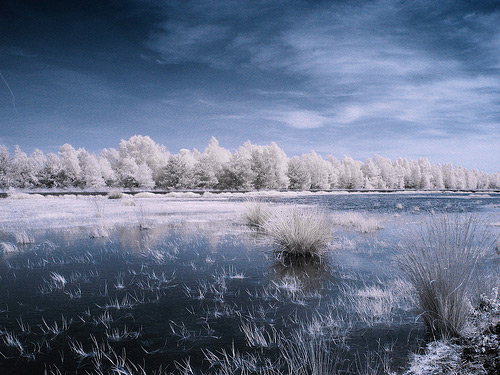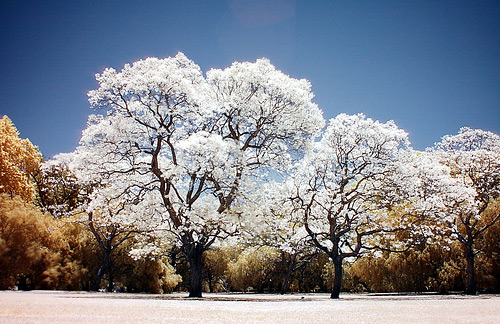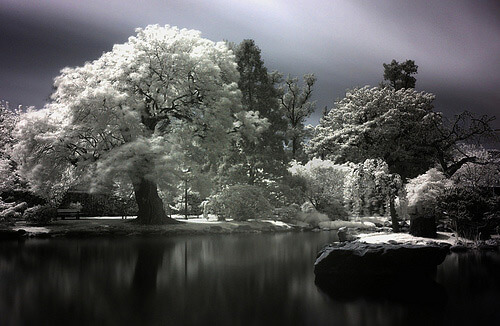Infrared photography is certainly a different way to look at the natural world. When you get ready to take scenic digital photography, take a look at your camera. Not all DSLR cameras have the ability to take this kind of imagery, but quite a few of them do and this is becoming an option that is more and more popular for modern digital cameras. If your camera does have the option of infrared photography, then you will definitely want to consider using this for landscapes.
Just What is Infrared Photography
In order to get started with infrared photography, you must understand a little more about infrared light. Infrared light cannot be seen by the eye. This is because it is a light that has a longer wavelength than any visible color. However, infrared light is all around us at all times. It is a type of light that bounces off of every object. If you have a camera that is capable of infrared (or IR), then the camera will be able to actually see this light and use it to create very interesting images.
In essence, when you view an IR image, it will have an opposite look to it. For example, a cloudy sky will look very dark and moody. Dark green trees will show up as various shades of light gray and white. Overall, the look will be dramatic and often very eerie. This look can be a fun way to get a new take on the landscapes that may otherwise be boring. Infrared photography can be quite tricky to get. Truly, you have to start thinking differently from standard digital photography. You will need the right equipment as well as some basic guidelines for taking the right images.
Equipment for Infrared Digital Photography
To start with, for your infrared digital photography, you will need the right equipment. This is not the type of photography that can use just any old camera, just any old lens and just any old situation. Here is a rundown of the equipment that you will need for this type of digital photography.
The Camera. Of course, you will need to have a camera. Not all DSLRs can take infrared photography, so make sure you have chosen a model that has the right built in equipment. If you are purchasing a camera specifically for infrared imagery, you will want to look for a camera that includes something called a “hot mirror.” This mirror will help to isolate the infrared light, use it for IR images and then block it for standard images.
The Filter. You can take images with infrared without the filter, but it will not be as clear and crisp. Specialty lens filters are designed to block out other wavelengths of light so all that your camera is seeing will be the infrared wavelengths. This will allow the image to be more dramatic in color. Keep in mind that not all infrared filters are the same. That may mean that you need to consider paying a little more for a high quality filter. For the most part, you can expect to pay between $50 and $100. It would not be advisable to choose a filter that costs less than this.
As far as lens, you will want to choose the right option based on the landscape that you are photographing. As mentioned with any landscape photography, it is a good idea to choose a versatile lens that includes both moderate telephoto as well as wide angle. This will give the best opportunities to capture the whole landscape while highlighting the most important parts of the image.
Pointers for Infrared Digital Photography
Long exposures are required in order to capture enough of the infrared light. You will need to choose to leave the aperture a low f/stop for a wide aperture in order to capture enough of the infrared light. You know what that means. You will need to consider the use of a tripod and a wireless shutter release or you may end up with way too much camera shake.
You cannot just assume metering is the same because the scene has similar lighting. Because you cannot see IR light, you will have no idea of what metering you need to use until you take the picture. That means you will need to experiment to get the right light metering with each image that you take.
Focusing can be a problem. Because IR light is so different from standard light, you cannot focus in the same manner as you would with standard digital photography. In fact, auto focus may not work at all. For that reason, you will need to practice with focusing the camera yourself.
You will have to learn how to see IR images when you are framing up the shot. Digital views and LCDs may have a very hard time showing you the image, which means you will have to practice to get the right photo. If you truly want to make the best of IR digital photography, then you may want to consider a camera that includes an optical viewing system and not digital.
Be careful of the lens you choose. There are some lenses out there that have an IR blocking coating. This type of coating can actually cause problems with your digital photography when you want to capture IR. You may need to research lenses or experiment with the lenses that you have to avoid the problem.
Many people consider IR digital photography as a great option when they feel their landscapes have become dull or even boring. Because infrared photography can capture landscapes in a whole new perspective, then you will find that it can be fun, interesting and exciting. It is important, though, that you think of this type of photography in a different way. You will need to choose the right equipment and you will need to learn some different things about capturing the image if you want to have success at IR.
Top feature image Park Kuskovo. Large Palace pondvia Shutterstock



